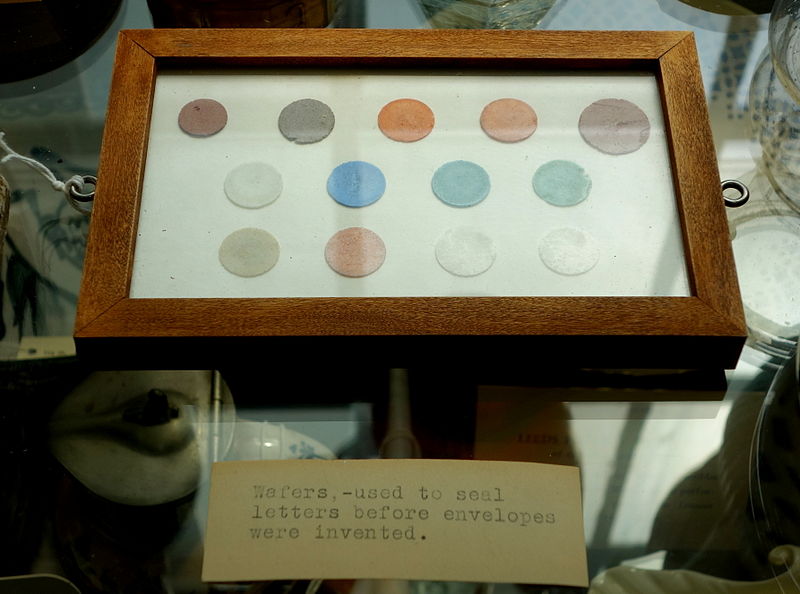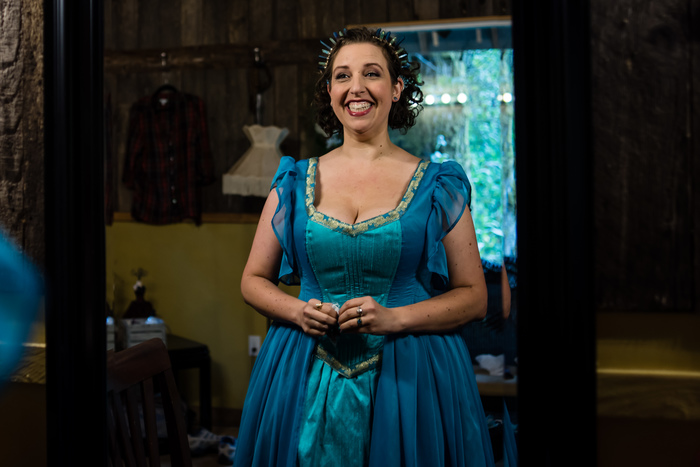Correspondence in the Regency was a regular task, usually undertaken by the ladies of the household, to impart news, conduct business, and connect with loved ones all over the country.
It was expected that one would take several days to write a letter, except in case of emergency. Given the expense of paper, we can assume this was at least in part to ensure the author had thoroughly decided what to say and how to say it, to reduce instances of scribbling out the wrong word.
The author would use a quill or dip pen, and iron or oak gall ink (available in grey/black, red, blue, yellow, and green), making the act of letter writing as much an art as it was a sharing of information. Although handwriting styles vary in extant letters from the period, good penmanship was clearly prized.
Paper
Paper of the era was made with linen or cotton fibers, so it withstood multiple folds and didn't crumble with age.
By the end of the Georgian period, paper makers had started to standardize paper size and the typical sheet of foolscap was 19-1/2" x 15-1/4".It could be trimmed or folded to quarto size, which was the same size as our standard A4 paper today. Then that quarto sheet would be folded in half, like a greeting card, and the front, inside left, and inside right areas would all be used for the letter.
Envelopes did not exist, so the external-facing "back" of the letter was where the sender addressed (and sealed) the letter.
If you were a wordy correspondent (as Miss Austen frequently was), you could write on some of that back side, to the sides of the center panel which would have an address on it (seen below and in this pdf example).
On this extant letter from Jane to her sister Cassandra, she also employs a technique known as 'cross-writing', where the author writes at a 90-degree angle to her original text. Why not add more paper? A second quarto sheet doubled the postage rate, and the recipient of the letter paid the postal fee.
Postage
Per the Act of 1805, a letter that weighed one ounce cost the recipient four times the base rate. The base rate was calculated by distance between sender and recipient. And from 1805-1812, the base rate for one sheet of paper was roughly 4 pence per every 15 miles the letter had to travel (though after 50 miles, a letter could travel further for that additional pence). In 1812, a new Act was passed that rather steeply increased the price.
One way around paying the postal fee was if it was mailed to or by members of Parliament, called "franking" a letter. Poor relations of members of Parliament, or servants within the household of a member of Parliament, frequently took advantage of this professional courtesy to avoid costing their recipients money in postal fees.
(hence Edmund suggesting to Fanny in Mansfield Park, "Yes, depend upon me it shall: it shall go with the other letters; and, as your uncle will frank it, it will cost William nothing.")
Privacy
To keep the contents of a letter private, some senders employed letterlocking techniques and some folded several times to create a flap so that those handling the letter before it reached its final destination could not accidentally see something private.
If necessary, the sender would use sealing wax or a wafer to seal the letter closed. A stick of wax would be gentle heated over a candle until a bit of it had dripped onto the fold, then a seal or signet would be pressed into it. Most wax of the time appears to have been red, though black and green extant samples have survived.
Alternately, one could use a wafer made of flour and gum- simply lick and stick.
Happily, the modern correspondent can recreate Regency-style letters quite easily.
- Laid paper can be found at most stationery stores (though if you're using modern fountain pen ink, a treated paper is better, to reduce ink feathering).
- Sealing wax and stamps are readily available online and in most stores (and wafers can be homemade using a typical play-dough style flour paste).
- Dip pens and quills can be purchased as desired (quills do take practice!)
- There are plenty of calligraphy resources (like The Postman's Knock) to help you perfect your penmanship.
You can even enter the giveaway to win a glass dip pen and fountain pen ink, to start you on your letter-writing journey!
Additional Sources:
- Shannon Donnelly's Fresh Ink
- Jane Austen's Writing, a Technical Perspective
- Jane Austen's World blog
- Her Reputation for Accomplishment
- A Touch of Quill and Ink
 |
| Click here to return to the master list of Austen in August posts! |












That cross-writing on the letter makes my eyes bug out, but the prices you listed for the miles makes it worth giving a go (since I sincerely doubt I would have been in the class to be related to an MP). :) Fascinating details about writing letters and stationery in the past. Thanks, Beth!
ReplyDeleteIsn't the cross-writing crazy? Really gives new meaning to the line about Bingley leaving out half his words, and blotting the rest -- if the letter was of any length, it would have made it even harder to read!
DeleteIt's amazing- I haven't had the opportunity to see one in person, but it kind of scrambles my brain to look at photos of it. On the plus side, being forced to be succinct and impactful with your words in daily correspondence may very well have contributed to Jane Austen's skill at imparting a lot of info about a character in a small set of sentences.
DeleteReally very happy to say,your post is very interesting to read.I never stop myself to say something about it.You’re doing a great job.Keep it up
ReplyDeleteI am always amazed by how every space of paper was often used as I don't understand how they could possibly read them especially those letters with cross-writing. I had never heard of wafers before and wonder how well they stuck. Thanks for sharing these interesting facts with us.
ReplyDelete